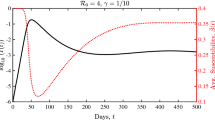Abstract
In this paper, we reformulate Kermack’s and McKendrick’s variable susceptibility model for infectious diseases as a nonlinear age-dependent population dynamics model, then we prove an existence and uniqueness result for the endemic steady state. Subsequently we discuss the local stability of the endemic steady state. Finally we show that Pease’s evolutionary epidemic model can be seen as a special case of the variable susceptibility model and discuss possible extensions.
Similar content being viewed by others
References
R.M. Anderson, Discussion: The Kermack-McKendrick epidemic threshold theorem. Bull. Math. Biol.,53, No. 1/2 (1991), 3–32.
R.M. Anderson and R.M. May, Infectious Diseases of Humans: Dynamics and Control. Oxford UP, Oxford, 1991.
O. Diekmann, Limiting behaviour in an epidemic model. Nonlinear Anal. TMA,1, No. 5 (1977), 459–470.
O. Diekmann, H. Heesterbeek and H. Metz, The Legacy of Kermack and McKendrick. Epidemic Models: Their Structure and Relation to Data (ed. D. Mollison), Cambridge University Press, Cambridge, 1995, 95–115.
M.E. Gurtin and R.C. MacCamy, Non-linear age-dependent population dynamics. Arch. Rational Mech. Anal.,54 (1974), 281–300.
M. Iannelli, Mathematical Theory of Age-Structured Population Dynamics. Giardini Editori e Stampatori in Pisa, 1995.
H. Inaba, Mathematical analysis for an evolutionary epidemic model. Mathematical Models in Medical and Health Sciences (eds. M.A. Horn, G. Simonett and G.F. Webb), Vanderbilt University Press, Nashville, 1998, 213–236.
H. Inaba, Revisiting Kermack and McKendrick. Mathematical Models and Functional Equations (ed. S. Sakata), Kokyuroku 1128, Research Institute for Mathematical Sciences, Kyoto University, 2000, 112–121.
H. Inaba, Endemic threshold and stability in an evolutionary epidemic model. To appear in Mathematical Approaches for Emerging and Reemerging Infectious Diseases: Models, Methods, and Theory (IMA Volumes), Springer, New York, 2001.
W.O. Kermack and A.G. McKendrick, Contributions to the mathematical theory of epidemics-I. Proceedings of the Royal Society,115A (1927), 700–721; Reprinted in Bull. Math. Biol.,53, No.1/2 (1991), 33–55.
W.O. Kermack and A.G. McKendrick, Contributions to the mathematical theory of epidemics-II. The problem of endemicity. Proceedings of the Royal Society,138A (1932), 55–83; Reprinted in Bull. Math. Biol.,53, No.1/2 (1991), 57–87.
W.O. Kermack and A.G. McKendrick, Contributions to the mathematical theory of epidemics-III. Further studies of the problem of endemicity. Proceedings of the Royal Society,141A (1933), 94–122; Reprinted in Bull. Math. Biol.,53, No.1/2 (1991), 89–118.
J.A.J. Metz and O. Diekmann (eds.), The Dynamics of Physiologically Structured Populations. Lecture Notes in Biomathematics68, Springer, Berlin, 1986.
J.A.J. Metz, The epidemic in a closed population with all susceptibles equally vulnerable; some results for large susceptible populations and small initial infections. Acta Biotheoretica,27, No. 1/2 (1978), 75–123.
C.M. Pease, An evolutionary epidemiological mechanism, with applications to type A influenza. Theor. Popul. Biol.,31 (1987), 422–452.
J. Prüss, Stability analysis for equilibria in age-specific population dynamics. Nonlinear Anal. TMA,7, No. 12 (1983), 1291–1313.
J. Prüss, On the qualitative behaviour of populations with age-specific interactions. Comput. Math. Appl.,9, No. 3 (1983), 327–339.
H. R. Thieme, Semiflows generated by Lipschitz perturbations of non-densely defined operators. Differential and Integral Equations,3, No. 6 (1990), 1035–1066.
H.R. Thieme and C. Castillo-Chavez, How may infection-age-dependent infectivity affect the dynamics of HIV/AIDS?. SIAM J. Appl. Math.,53, No. 5 (1993), 1447–1479.
G.F. Webb, Theory of Nonlinear Age-Dependent Population Dynamics. Marcel Dekker, New York and Basel, 1985.
Author information
Authors and Affiliations
Corresponding author
Additional information
This paper is dedicated to the memory of Professor YAMAGUTI Masaya (1925–1998).
About this article
Cite this article
Inaba, H. Kermack and McKendrick revisited: The variable susceptibility model for infectious diseases. Japan J. Indust. Appl. Math. 18, 273–292 (2001). https://doi.org/10.1007/BF03168575
Received:
Revised:
Issue Date:
DOI: https://doi.org/10.1007/BF03168575




